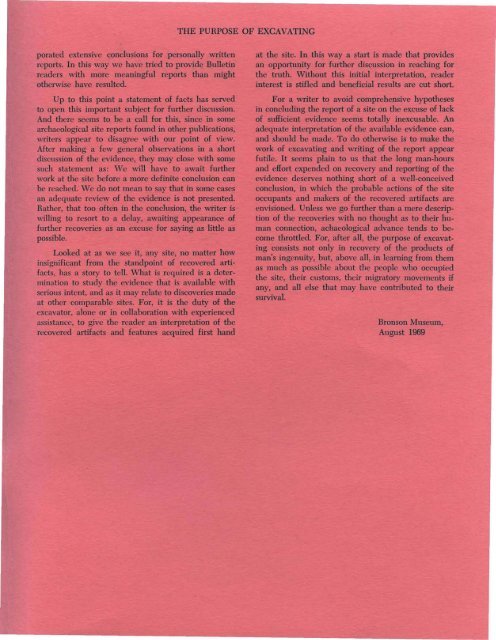The First Scientific Tool of Man, 31(3-4)
The First Scientific Tool of Man, 31(3-4)
The First Scientific Tool of Man, 31(3-4)
You also want an ePaper? Increase the reach of your titles
YUMPU automatically turns print PDFs into web optimized ePapers that Google loves.
porated extensive conclusions for personally written<br />
reports. In this way we have tried to provide Bulletin<br />
readers with more meaningful reports than might<br />
otherwise have resulted.<br />
Up to this point a statement <strong>of</strong> facts has served<br />
to open this important subject for further discussion.<br />
And there seems to be a call for this, since in some<br />
archaeological site reports found in other publications,<br />
writers appear to disagree with our point <strong>of</strong> view.<br />
Mter making a few general observations in a short<br />
discussion <strong>of</strong> the evidence, they may close with some<br />
such statement as: We will have to await further<br />
work at the site before a more definite conclusion can<br />
be reached. We do not mean to say that in some cases<br />
an adequate review <strong>of</strong> the evidence is not presented.<br />
Rather, that too <strong>of</strong>ten in the conclusion, the writer is<br />
willing to resort to a delay., awaiting appearance <strong>of</strong><br />
further recoveries as an excuse for saying as little as<br />
possible.<br />
Looked at as we see it, any site, no matter how<br />
insignificant from the standpoint <strong>of</strong> recovered artifacts,<br />
has a story to tell. What is required is a determination<br />
to study the evidence that is available with<br />
serious intent, and as it may relate to discoveries made<br />
at other comparable sites. For, it is the duty <strong>of</strong> the<br />
excavator, alone or in collaboration with experienced<br />
assistance, to give the reader an interpretation <strong>of</strong> the<br />
recovered artifacts and features acquired first hand<br />
THE PURPOSE OF EXCAVATING<br />
at the site. In this way a start is made that provides<br />
an opportunity for further discussion in reaching for<br />
the truth. Without this initial interpretation, reader<br />
interest is stifled and beneficial results are cut short.<br />
For a writer to avoid comprehensive hypotheses<br />
in concluding the report <strong>of</strong> a site on the excuse <strong>of</strong> lack<br />
<strong>of</strong> sufficient evidence seems totally inexcusable. An<br />
adequate interpretation <strong>of</strong> the available evidence can,<br />
and should be made. To do otherwise is to make the<br />
work <strong>of</strong> excavating and writing <strong>of</strong> the report appear<br />
futile. It seems plain to us that the long man-hours<br />
and eHort expended on recovery and reporting <strong>of</strong> the<br />
evidence deserves nothing short <strong>of</strong> a well-conceived<br />
conclusion, in which the probable actions <strong>of</strong> the site<br />
occupants and makers <strong>of</strong> the recovered artifacts are<br />
envisioned. Unless we go further than a mere description<br />
<strong>of</strong> the recoveries with no thought as to their human<br />
connection, achaeological advance tends to become<br />
throttled. For, after all, the purpose <strong>of</strong> excavating<br />
consists not only in recovery <strong>of</strong> the products <strong>of</strong><br />
man's ingenuity, but, above all, in learning from them<br />
as much as possible about the people who occupied<br />
the site, their customs, their migratory movements if<br />
any, and all else that may have contributed to their<br />
survival.<br />
Bronson Museum,<br />
August 1969
















